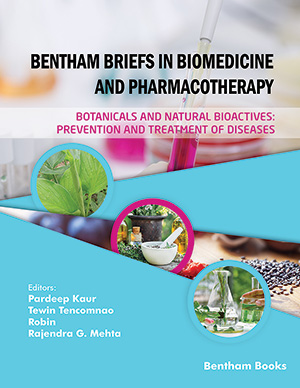Abstract
Aims: The main goal of this work is to synthesize new original spirocyclic hydroxamic acids, investigate their cytotoxicity against the panel of tumor cell lines and possible mechanism of action of these active compounds.
Background: Hydroxamic acids are one of the promising classes of chemical compounds with proven potential anticancer properties. This is manifested in the presence of metal chelating and antioxidant activities, the ability to inhibit histone deacetylase enzymes and a chemosensitizing effect against well known cytostatics.
Objective: Original spirocyclic hydroxamic acids were synthesized and spectra of their antiproliferative activities were investigated.
Methods: The cytotoxic activities on different tumor lines (SH-SY5Y, HeLa and healthy cells HEK-293) were investigated and determined possible underlying mechanisms of their activity.
Results: New original spirocyclic hydroxamic acids were synthesized. These compounds exhibit antiproliferative properties against various tumor cultures cells and also exhibit antioxidant activity, a depolarizing effect on the mitochondrial membrane, inhibit the activity of the histone deacetylase enzyme, and also decrease of basal glycolysis and glycolytic capacity reserve of HeLa and SH-SY5Y tumor cell lines.
Conclusion: The most promising are compounds 5j-l containing two chlorine atoms as substituents in the quinazoline part of the molecule and hydroxamate function. Therefore, these compounds can be considered as hit compounds for the development on their basis multi-target anticancer agents.
Keywords: Anti-cancer agents, hydroxamic acids, cytotoxicity profile, potential antioxidant properties, mitochondria, histone deacetylases, glycolysis.
[http://dx.doi.org/10.3322/caac.21262] [PMID: 25651787]
[http://dx.doi.org/10.1007/978-3-319-24223-1_1] [PMID: 26667336]
[http://dx.doi.org/10.1002/med.20200] [PMID: 20162725]
[http://dx.doi.org/10.2174/1568009617666170623104030] [PMID: 28669342]
[http://dx.doi.org/10.2217/fon.11.2] [PMID: 21345145]
[http://dx.doi.org/10.1155/2016/6719534] [PMID: 26682013]
[http://dx.doi.org/10.1016/j.tcb.2008.01.006] [PMID: 18296052]
[http://dx.doi.org/10.18632/oncotarget.2289] [PMID: 25115382]
[http://dx.doi.org/10.1158/1078-0432.CCR-07-0074] [PMID: 17575208]
[http://dx.doi.org/10.1007/978-1-4939-6960-9_1] [PMID: 28470513]
[http://dx.doi.org/10.2460/javma.248.7.789] [PMID: 27003020]
[http://dx.doi.org/10.2174/1871527315666161107090525] [PMID: 27823572]
[http://dx.doi.org/10.2478/intox-2013-0003] [PMID: 24170974]
[http://dx.doi.org/10.1016/j.phymed.2005.03.009] [PMID: 16635742]
[http://dx.doi.org/10.1016/0014-5793(76)80434-6] [PMID: 976474]
[http://dx.doi.org/10.1007/978-1-4939-9027-6_18] [PMID: 30725464]
[http://dx.doi.org/10.1021/ja01211a057] [PMID: 20990988]
[http://dx.doi.org/10.1021/je00032a042]
[http://dx.doi.org/10.1007/s13738-015-0680-2]
[http://dx.doi.org/10.1016/j.jecm.2012.06.001]
[http://dx.doi.org/10.1016/j.biocel.2006.07.001] [PMID: 16978905]
[PMID: 22035889]
[http://dx.doi.org/10.1038/nrd2060] [PMID: 16732220]
[http://dx.doi.org/10.1016/j.foodres.2010.10.055]
[http://dx.doi.org/10.4155/fmc.14.86] [PMID: 25329197]
[http://dx.doi.org/10.1016/j.taap.2006.12.025] [PMID: 17306316]
[http://dx.doi.org/10.5414/CPP46564] [PMID: 19000554]
[http://dx.doi.org/10.1016/j.jaad.2011.10.028] [PMID: 22794825]
[PMID: 20514403]
[http://dx.doi.org/10.1016/j.fct.2011.03.033] [PMID: 21440026]
[http://dx.doi.org/10.1016/j.lfs.2010.06.014] [PMID: 20619277]
[http://dx.doi.org/10.1038/35048073] [PMID: 11413468]
[http://dx.doi.org/10.1038/sj.bjc.6604554] [PMID: 18766181]
[http://dx.doi.org/10.1038/srep23552] [PMID: 27003027]
[http://dx.doi.org/10.1016/j.mam.2009.08.002] [PMID: 19698742]
[http://dx.doi.org/10.1038/nrd3137] [PMID: 20467424]
[http://dx.doi.org/10.1038/nchembio.1712] [PMID: 25517383]
[http://dx.doi.org/10.1016/j.ceb.2007.02.003] [PMID: 17303407]
[http://dx.doi.org/10.2174/1871520616666161031143301] [PMID: 27804847]
[http://dx.doi.org/10.1038/nrc1478] [PMID: 15516961]































